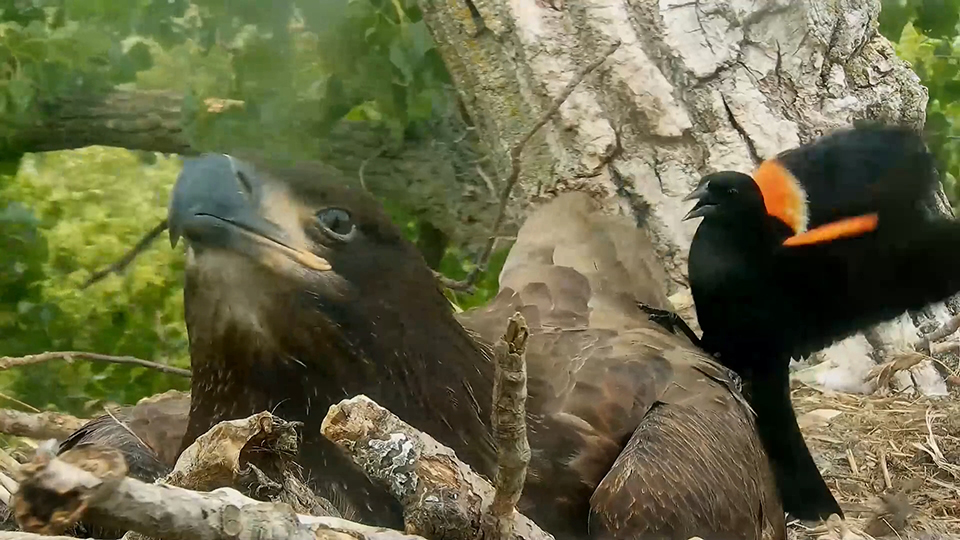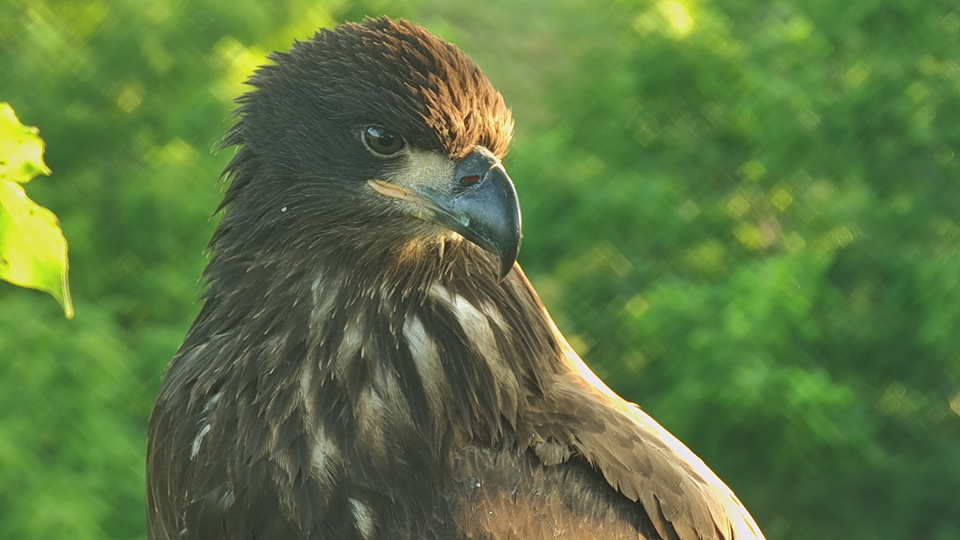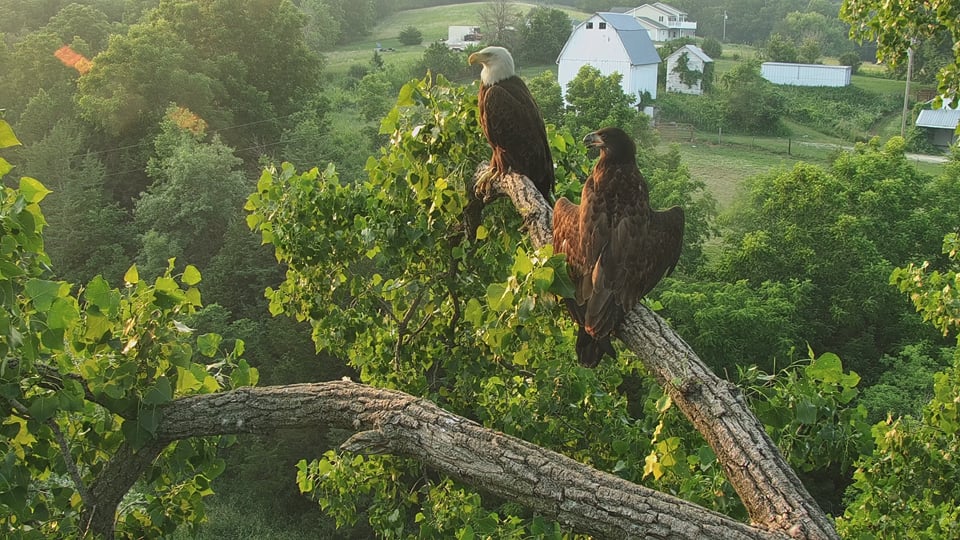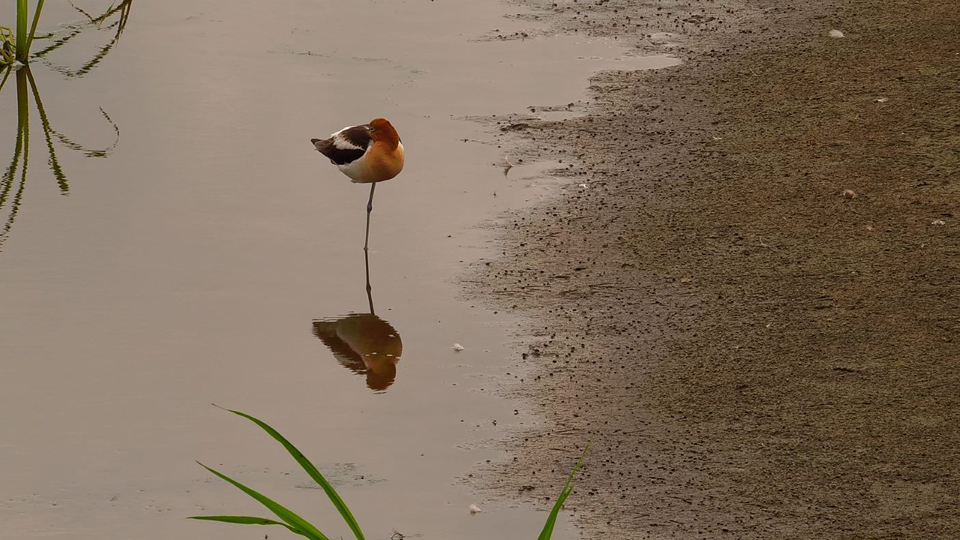Looking to escape the heat? Sit down somewhere cool and enjoy our NestFlix! In Decorah, DH2 is learning the skills it will need post-dispersal. How long is our eaglet likely to stick around? Brett Mandernack’s Decorah Eagle transmitter study found that eaglets averaged 162 days of age at dispersal, which means that DH2 is most likely to disperse on or around September 15. However, we might see and hear less of our eaglet in the coming days. DH2 is almost a month past dispersal and will probably begin ranging out on exploratory flights – an important precursor to leaving the nest for good.

DH2 and the Red-winged Blackbird
What’s going on with the red-winged blackbird that’s been pestering DH2? I talked to a researcher who studies icterid blackbirds. After reviewing the video, she identified it as an overactive attack behavior, since the alarm calls, the dives, and the pecking looked like real attacks. We have no idea what caused it to go into attack overdrive, but – much like a pesky bottlefly – it is bothering but not harming DH2. We’re not sure what it’s going to do with its time once DH2 disperses!
We also have videos from the Mississippi Flyway, which is especially enjoyable in hot, humid weather. Our camera operators and video makers found bald eagles, big fish, ducklings, and American Avocets for your enjoyment! We hope you enjoy them as much as we did. Stay cool, everybirdy!
Decorah Eagles

DH2 has a nice crop under its beautiful feathers. I love how the sun gilds it in golden light.
July 24, 2023: DH2 picks on nestovers and digs in the nest – https://youtu.be/0hOtMYiKCEI. DH2 flies into the nest, finds an old piece of squirrel jerky, and begins nibbling at it. We get a nice side view beginning at 3:30. At 7:48, the eaglet stops nibbling and begins paying attention to something below the nest. I’m not sure DH2 can see what it’s looking at, but it appears to be listening intently. At 8:24, DH2 startles and leaps across the nest, running back and forth. The eaglet continues to alternate looking with leaping and finally flies out at 9:22.

June 27, 2023: HM and DH2 enjoy a quiet evening on the Y
HM and HD are still providing some food support, but it’s important that DH2 learn to find its own food. While hunting and fishing are important, nestover jerky can provide calories and (some) nutrition to a young eagle who is still learning the finer points of predation! Estimates of carrion as a percentage of total food intake vary, but some researchers believe that it might comprise up to 80% of a newly dispersed eagle’s diet.
July 24, 2023: DH2 on a morning visit on the tree near the bluffs – https://youtu.be/wL2NP9DLKio. Three lovely, peaceful minutes of DH2 perched on the bluff.
Mississippi Flyway
July 20, 2023: Eagle has a huge fish – https://youtu.be/j1uUDeXQxaA. Exactly as the title says. I have no idea how much the fish weighs, but it is a whopper of a catch!
July 18, 2023: Mama Mallard & ducklings – https://youtu.be/YkXozS7OR0k. Six mallard ducklings dabble and swim under the watchful eye of their mother. At 1:32, she begins to swim away and the line up and follow her until they find another spot that meets Mama’s approval. Once again, the ducklings forage while she watches over them. The group leaves quickly at 3:02 and heads straight for the rushes, which makes me wonder what she saw and/or heard to lead them under cover. The camera finds the little family at 4:49 and we get some really cute looks starting at about 5:04.
The little ducklings are mobile, but they still need a lot of help from their mother! She needs to help them find food, protect them from predators, guide them during migration, and help them locate suitable staging and wintering habitat. When the young ducks can finally fly and the family migrates, they will join a large mixed-species flock of ducks, traveling as a small family unit within a much larger group of ducks. I love that they travel together for the young ducks’ first migration!

June 25, 2023: An American Avocet on the Flyway
June 25, 2023: American Avocets – https://youtu.be/tDuTQrqW_8E. This is cool! Two avocets in breeding plumage are foraging for food in the shallow waters just off a sandbar. They scythe or sweep their bills from side to side, stirring up mud, sand, and silt to capture small invertebrates dislodged by their bills. It isn’t all that common to see them in eastern Minnesota. The species breeds in and migrates through the great plains, ranging west from the Minnesota River in west central Minnesota to the foothills of the great Rocky Mountains. Although they are adults in breeding plumage, we have yet to see young, which means they probably aren’t nesting here.
Why are these birds in breeding plumage if they aren’t nesting? The term ‘breeding plumage’ refers to the plumage of an adult bird during breeding season, whether it is breeding or not. At one time, it was widely believed that almost all birds began breeding as soon as they reached sexual maturity. We now know this isn’t true: individuals might delay breeding based on nest site and/or mate availability, competition, behavioral traits, or other factors. Breeding plumage signifies that a bird is capable of breeding, but does not tell us whether it is actually doing so.
I couldn’t resist sharing these turtles. What turtles might we see in Lake Onalaska? A link: https://files.dnr.state.mn.us/eco/nongame/turtle_poster.pdf.
Odds and Ends
Speak now on Sny Magill: Erosion from flooding is threatening the 112 Native American mounds at Sny Magill, the southernmost, bottomland unit of Effigy Mounds National Monument near McGregor, Iowa, along Johnson Slough. These ceremonial and burial mounds are sacred to Native Americans. The Army Corps of Engineers wants to stabilize the bank in the area and is seeking comments through August 11. Comments and questions can be submitted to [email protected].
The U.S. Fish and Wildlife Service is seeking comments until September 3 on construction of a 5,000- to 6,000-square-foot visitor center, multipurpose space and office for the Upper Mississippi River National Wildlife and Fish Refuge, McGregor District. The building will be built within the footprint of the former Luster Heights prison farm – a very cool use of the now-closed facility. Direct comments to Upper Mississippi River National Wildlife and Fish Refuge, McGregor District, Attn: Kendra Pednault, 470 Cliff Haven Rd., Prairie du Chien, WI 53821 or [email protected].
 The Raptor Resource Project
The Raptor Resource Project The Raptor Resource Project
The Raptor Resource Project